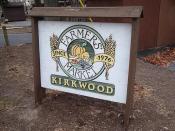LiPari Landfill is just one of 115 landfills and hazardous waste sites in New Jersey. LiPari is a fifteen acre municipal and industrial waste landfill first opened in 1958.
LiPari Landfill is located in Mantua Township, New Jersey. Mantua is a small town in South Jersey neighboring Pitman Township and Glassboro. The landfill is bordered by the Zee Orchard on the north and the west and a housing development on the northeast. Numerous lakes, streams and marshlands are in close proximity to the landfill. The Kirkwood aquifer, which lies beneath the ground, provides the groundwater for drinking water supplies that nearly 11,000 people in a three mile area depend on.
Nicholas LiPari first bought the land in 1958 to excavate a sand and gravel business. Soon after excavation began trenches appeared. LiPari allowed local municipalities and Burroughs to dump household solid waste, liquid and semi-solid chemical wastes, and other industrial materials.
Records were not kept, but it is estimated that roughly three million gallons of liquid wastes and 12,000 cubic yards of solid waste were deposited on the site. Dumping continued for a fourteen year period, beginning in 1958 and continuing through 1971.
Out of over 700 ranked sites, LiPari is listed number one (1) on the National Priority List (NPL), a list created to rank all landfills and hazardous waste sites identified as particularly dangerous. Due to its high concentrations of hazardous wastes, toxins, volatile organic compounds (VOCs), LiPari Landfill was first proposed for NPL listing on October 10, 1981 and was granted September 8, 1983. Groundwater, surface water, sediments, and air are all contaminated with VOCs such as Bis (2-choroisopropyl) ether, toluene, formaldehyde solution, and benzene. Methylene chloride, phenols, as well as other toxic organics contribute to the degradation of a vast ecosystem that once flourished in...


